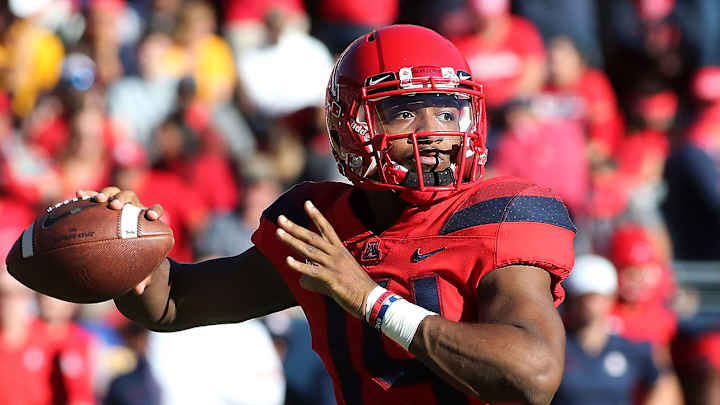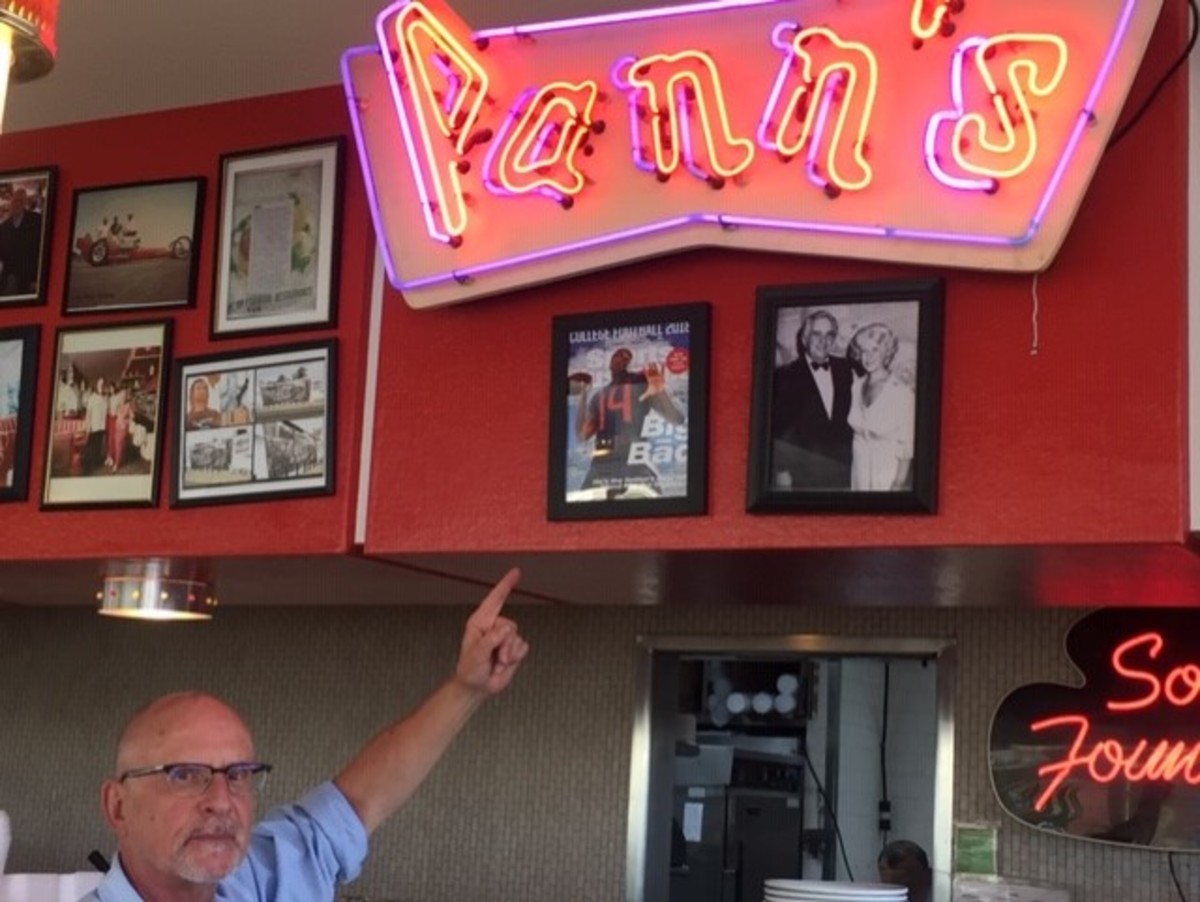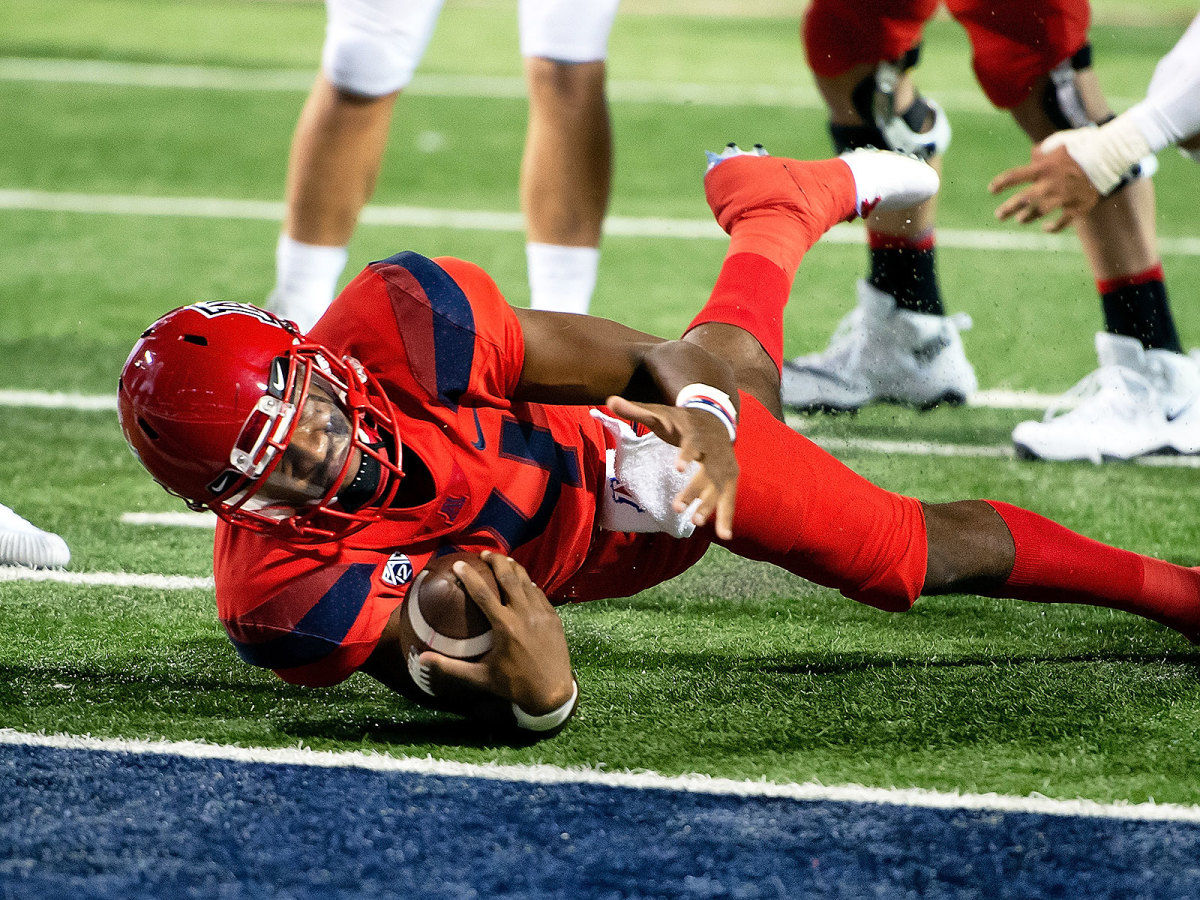With the Injuries (and the Hype) Behind Him, Khalil Tate Resolves to Write a New Chapter

LOS ANGELES — Pann’s Restaurant sits at the corner of two intersecting boulevards, La Cienega and La Tijera, nestled in one of LA’s largest suburban neighborhoods, Inglewood. The restaurant’s interior is modeled after a 1950s diner: A long bar is host to swiveling white stools, and cushioned red booths are staggered along a wall of windows. The menu includes such items as fried chicken wings and waffles, homemade onion rings, southern fried pork chop, Texas-style French toast and, if you’re feeling spicy, the three-egg fajita omelet.
The restaurant’s walls are home to many interesting pieces, but one is especially integral to this story. Beneath a brightly lit neon sign spelling out the diner’s name and just above the soda fountain machine, there hangs, framed behind glass, a Sports Illustratedmagazine cover from last August, portraying on its glossy face one of Pann’s regular customers, Arizona quarterback Khalil Tate, his right arm cocked in preparation to release the football in his hand. The first three words overlaid on the photo are enlarged for emphasis, followed by two sentences. “BIG AND BAD,” it reads. “He’s the nation’s best QB. (Hand him the Heisman).”

By the end of his junior season last year, Tate was distant from any Heisman Trophy consideration, an injury-riddled kid having captained a 5–7 squad that, despite his valiant efforts through the air (he threw for 2,530 yards and 26 touchdowns), lost one too many games for a bowl trip. Hampered by a trio of injuries, Tate completely missed one game, sat the bench for parts of two others and, so fed up with hate flung his way on social media, temporarily deleted the Twitter application from his phone. His parents were a sounding board for a son reluctant to reveal publicly the depths of his injuries. “He’d tell us,” says Brian Tate, Khalil’s father. “He had more than just the ankle. He had a shoulder and toe. I know my son—I know when he can’t do his best, it frustrates him.”
Months later, the most frustrating stretch of his career behind him, Khalil Tate can now himself address his 2018 season and how, he admits, he struggled at times handling the weight and celebrity that comes with being a cover boy. He could find no one to empathize with him. “I don’t know anybody that’s ever been on the cover. I can’t call them up. That was the hardest thing,” he says. And then there were the injuries, the physical portion of the problem during a sometimes unsatisfying year.
“It was very difficult. Knowing what I can do when I am healthy… Not being able to be healthy is kind of like, ‘Ah, I wish I can do this and wish I can do that, but I physically can’t,’” Khalil says in a candid interview with Sport Illustrated from his hometown of Los Angeles. “I couldn’t run. It’s not that I didn’t want to run. I wanted to, but I couldn’t.” No, it wasn’t defensive coordinators, facing him a second straight year, bottling him up, and it wasn’t a brand new offense forcing him to pass from the pocket. It was because he was hurt. “It’s that simple,” says Kevin Sumlin, entering his second year as Tate’s coach at Arizona.
Tate sprained his left ankle on the second play of the second game of the season at Houston. He then re-injured an old shoulder joint in Game 4 against Oregon State and, finally, spent half of November fighting a bout of turf toe. The ankle was the worst of them, so bad that Tate’s high school coach back in Los Angeles described it as such: “The injury was more serious than he let Arizona medical staff know,” says Marvin Pollard, defensive backs coach at Junipero Serra high school. “He told them, ‘I’m good I’m good,’ when he probably shouldn’t have played.” The ankle never really healed through the course of the season. Ankle sprains are pesky and often take weeks, if not months, to completely heal. He’d often take off practice Monday-Thursday each week before re-injuring the ankle on Saturday. Tate wasn’t even fully healthy at the start of Arizona’s spring practice in March, wearing a special high-top cleat to protect the ankle. He finally felt 100% in late April.
Dealing with the effects of a season-long ankle sprain, Tate ran for one-sixth of the yards he rushed for during his sophomore season, and he twice rushed for more yards in a single game in 2017 than he did in all of 2018 (224). The drop in his rushing numbers had many believing Sumlin and new offensive coordinator Noel Mazzone were attempting to turn Tate into a pocket passer. Mazzone only inflamed those thoughts after a season-opening 28–23 loss to BYU, when he told an ESPN broadcasting crew before the next game, “Last week, I tried to turn Khalil Tate into Peyton Manning.” A day later, Tate sprained the ankle at Houston. “A lot of people think I was trying to be a pocket passer, but I couldn’t run. What else am I going to do?” If you’re looking for positives to Tate’s 2018 season, it’s that one: He orchestrated an efficient passing offense, throwing for more than 230 yards a game, finishing with a 3-to-1 touchdown-to-interception ratio and completing 56% of passes. It wasn’t such a bad 2018 after all, right? “I think people wanted him to have this super mega year and he didn’t, but he had a good year,” Brian Tate says. “His so-called bad year is still good.”

Some might wonder why he played at all on such a bum ankle. Khalil admits to thinking about the next level. He knew NFL scouts and executives were watching. He didn’t want to seem soft. It crept into his mind a few times: Maybe I should sit out? In the end, the only game he missed was at UCLA. “I could have sat out and not played, but that wouldn’t have really helped my brand, and I wanted to play just for my team also,” he says. Like every other young dual-threat quarterback, Khalil watched last fall as rookie and former Heisman winner Lamar Jackson carved through NFL defenses to lead the Ravens to the AFC North championship, inspirational proof that a quarterback of his kind can succeed on the next level, says Pollard. However, the buzz on Tate at the next level isn’t loud, as one NFL scout described it, and you won’t find him listed on many draft projections at quarterback. Is a position move in his future at the NFL? Maybe, but he’s determined to play quarterback. It’s the same mentality he took from high school to college despite many coaches, like Alabama offensive coordinator Steve Sarkisian, recruiting him as an athlete.
In his final hurrah this season, Tate can create NFL buzz by combining his passing output of 2018 with the rushing skills he showed in 2017, when he electrified the nation with a pair of records: the most single-game yards rushing for a quarterback in NCAA history (327) and the most yards rushing by any one player in the month of October in at least a decade (840). This time around, the expectations nationally are at a minimum. Tate doesn’t crack the top 20 in Heisman Trophy odds this August. This time last year, he made the top five. Locally here in Los Angeles, the expectations are still high. “We expect big things. He’s going to show out,” Brian Tate says. “He’s going to show people what happens when he’s 100% healthy.” Pollard has confidence that if he can stay healthy, Khalil can replicate that furious stretch in October 2017. Significant changes happened this offseason. Khalil trimmed his frame, becoming leaner and faster. He also bonded with Sumlin, Pollard says. “They ‘get’ each other now. It takes some time to ‘get’ each other,” he says.
Another thing different about this August: Khalil is not on a regional cover of Sports Illustrated. And maybe that’s a good thing. Those close to Khalil say the cover created a weight that rested heavily on his 215-pound frame. It turned him into a celebrity, especially locally back home. “A lot was expected,” Pollard says. On social media, reactions to the cover filled his mentions column, some positive and others negative, the latter questioning his worthiness and abilities. He soon deleted the app on his phone. “I know the animal Twitter can become,” says Tate, who graduated this past May. “The more I’m away from that, the easier I can live my regular life without that nonsense. That’s where a lot of athletes go wrong, being too into that.”
The Sports Illustrated cover is, of course, more permanent. When he frequents Pann’s Restaurant, there on the wall staring back at him is—and might always be—his face, that right arm cocked about to release a pass and those big, bulging words at the bottom. Feelings of regret or disappointment don’t wash over him, he says. In fact, it’s the opposite. “It’s an honor. Even though things didn’t go as planned, people that walk in and kids that walk in will still see that and maybe it’ll help a kid out of Inglewood. ‘Oh, who is that?’” Tate says. “‘He’s from here.’ I see the bigger picture.”
Maybe, one day, he’ll appear on another cover, and it’ll hang next to that one inside of Pann’s. “If he stays healthy,” Pollard says, “he can return to old Khalil Tate and be the Heisman mix.”
